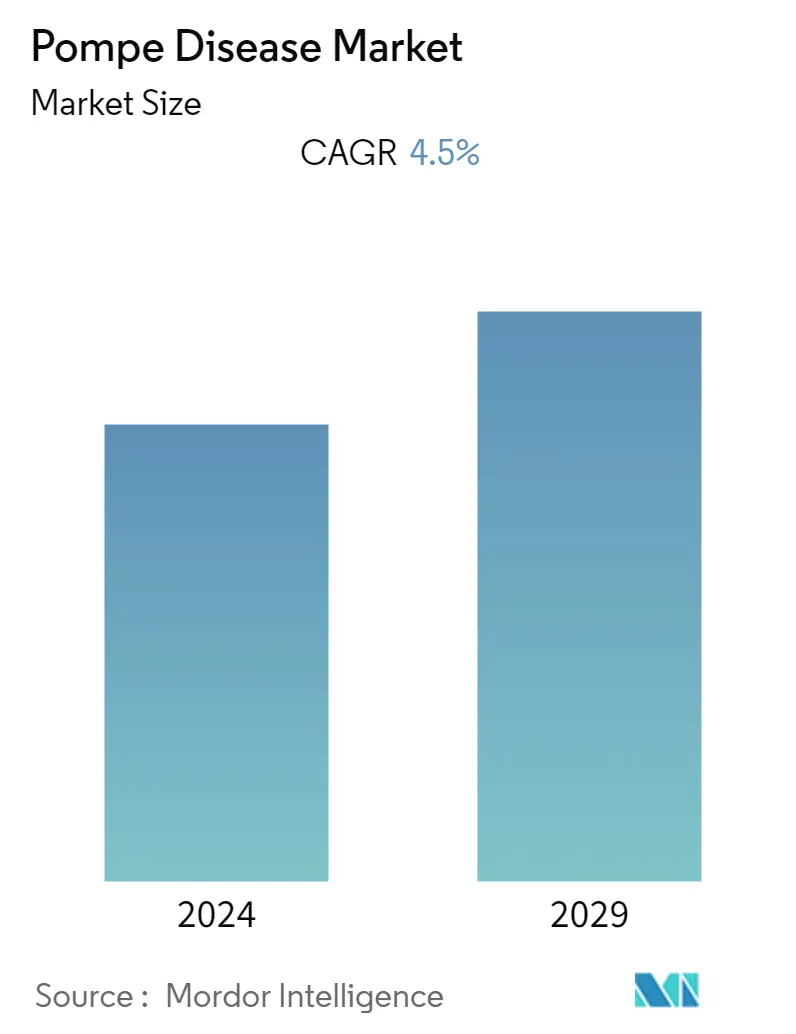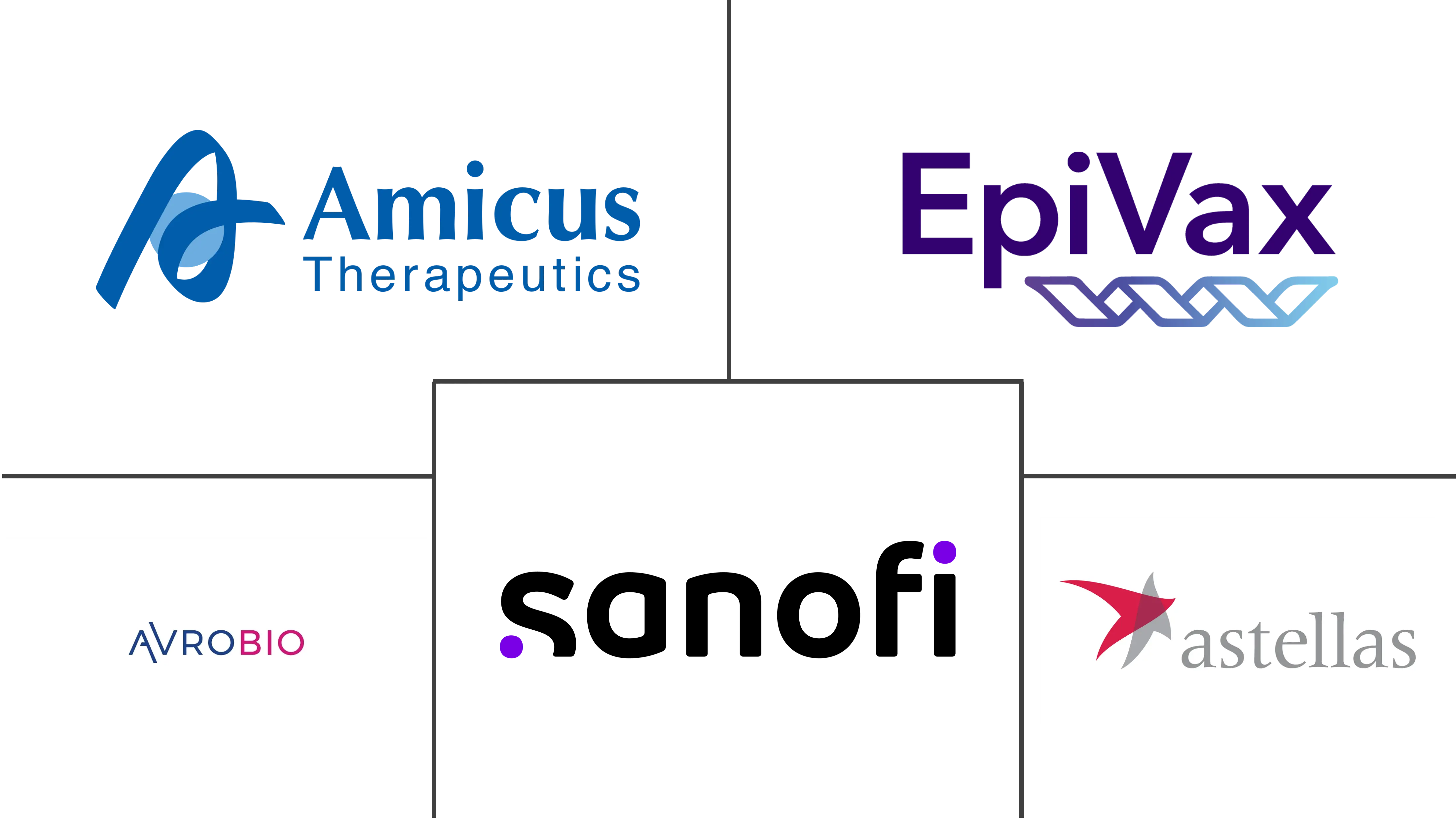Market Size of Pompe Disease Industry

| Study Period | 2019 - 2029 |
| Base Year For Estimation | 2023 |
| CAGR | 4.50 % |
| Fastest Growing Market | Asia-Pacific |
| Largest Market | North America |
| Market Concentration | Medium |
Major Players
*Disclaimer: Major Players sorted in no particular order |
Pompe Disease Market Analysis
The Pompe disease market is expected to register a CAGR of 4.5% over the forecast period.
The COVID-19 pandemic impacted market growth. It resulted in benign Pompe diseases in many individuals. For instance, according to the NCBI research study published in March 2022, in some Pompe disease patients, the COVID-19 infection could have a benign outcome. The same source also stated that individuals with Pompe disease were at a high risk of acquiring COVID-19 infection. Thus, the outbreak of the pandemic increased the incidence rate of Pompe disease, which significantly increased the demand for drugs and treatment for the disease and is expected to maintain the upward trend over the forecast period.
The market's growth is largely attributed to the launch of novel drugs and the continued uptake of long-term therapies. Pompe disease is a rare disease classified as early infantile or late-onset, majorly affecting skeletal muscle, heart defects, and breathing problems. For instance, according to the National Institute of Health publication from April 2022, Pompe disease affects 1 in 40,000 individuals in the United States. Moreover, according to the research study published in June 2021, pathogenic or likely pathogenic variants (PLPVs) were found in higher proportions in East Asian and African patients with classic infantile-onset Pompe disease. The same source also reported that in the general population, total carrier frequency (CF) and predicted genetic prevalence (pGP) were 1.3 percent (1 in 77) and 1:23,232, respectively. Thus, the rising prevalence of Pompe disease is anticipated to boost market growth over the forecast period.
The launch of novel drugs is anticipated to boost demand for the treatment of Pompe disease, which may further drive market growth. Moreover, increasing R&D expenditure globally will also promote working on novel therapeutics and the treatment of Pompe disease, as this disease mostly leads to death if not treated at an early stage. For instance, in February 2021, Genethon launched a gene therapy clinical trial for late-onset Pompe disease, led by the company Spark Therapeutics, using technologies developed at Genethon. Furthermore, increasing development in enzyme replacement therapies and gene therapy may also create a lucrative opportunity for the Pompe disease market over the forecast period, as this therapy is widely used to treat this disorder. Therefore, increasing product launches and research and development related to Pompe disease are anticipated to spur market growth over the forecast period.
However, high treatment costs associated with Pompe disease may restrain market growth over the forecast period.
Pompe Disease Industry Segmentation
As per the scope of the report, Pompe disease, also known as glycogen storage disease type II disorder, is an autosomal recessively inherited metabolic disorder caused by glycogen accumulation in the lysosome. Pompe disease is a rare (estimated at 1 in every 40,000 births), inherited, and often fatal condition that disables the heart and skeletal muscles. It is caused by mutations in a gene that makes an enzyme called acid alpha-glucosidase (GAA). The Pompe Disease Market is segmented by Route of Administration (Oral and Parenteral), Treatment Type (Substrate Reduction Therapy (SRT), Enzyme Replacement Therapy (ERT), and Others), End User (Hospitals, Ambulatory Surgery Centers, and Others), and Geography (North America, Europe, Asia Pacific, the Middle East and Africa, and South America). The report offers the value (in USD million) for the above segments. The market report also covers the estimated market sizes and trends for 17 countries across major regions globally. The report assigns a value of (USD million) to the aforementioned segments.
| By Route of Administration | |
| Oral | |
| Parenteral |
| By Treatment Type | |
| Substrate Reduction Therapy (SRT) | |
| Enzyme Replacement Therapy (ERT) | |
| Other Treatment Types |
| By End-User | |
| Hospitals | |
| Ambulatory Surgical Centers | |
| Other End-Users |
| Geography | ||||||||
| ||||||||
| ||||||||
| ||||||||
| ||||||||
|
Pompe Disease Market Size Summary
The Pompe disease treatment market is poised for growth, driven by the introduction of novel drugs and the ongoing adoption of long-term therapies. Pompe disease, a rare condition affecting skeletal muscles, heart function, and respiratory health, has seen increased incidence due to the COVID-19 pandemic, which has heightened the demand for effective treatments. The market's expansion is further supported by advancements in enzyme replacement therapies and gene therapy, which offer promising avenues for treatment. The rising prevalence of Pompe disease, particularly in specific genetic populations, is expected to bolster market growth as more individuals seek therapeutic interventions. However, the high costs associated with these treatments may pose challenges to market expansion.
North America is anticipated to experience significant growth in the Pompe disease treatment market, fueled by the presence of numerous pharmaceutical companies, substantial research and development investments, and a preference for advanced therapies. The region's market growth is also supported by key product launches and strategic partnerships among major industry players. The effectiveness of enzyme replacement therapy, the only FDA-approved treatment for Pompe disease, continues to drive demand in this segment. Additionally, government initiatives and programs aimed at assisting patients with medical expenses are expected to further stimulate market growth. The competitive landscape is characterized by the presence of major companies such as Amicus Therapeutics, Sanofi, and Genethon, which are actively involved in developing and marketing treatments for Pompe disease.
Pompe Disease Market Size - Table of Contents
-
1. MARKET DYNAMICS
-
1.1 Market Overview
-
1.2 Market Drivers
-
1.2.1 Launch of Novel Drugs
-
1.2.2 Continued Uptake of Long Term Therapies
-
-
1.3 Market Restraints
-
1.3.1 High Treatment Cost
-
-
1.4 Porter's Five Forces Analysis
-
1.4.1 Threat of New Entrants
-
1.4.2 Bargaining Power of Buyers/Consumers
-
1.4.3 Bargaining Power of Suppliers
-
1.4.4 Threat of Substitute Products
-
1.4.5 Intensity of Competitive Rivalry
-
-
-
2. MARKET SEGMENTATION (Market Size by Value - USD Million)
-
2.1 By Route of Administration
-
2.1.1 Oral
-
2.1.2 Parenteral
-
-
2.2 By Treatment Type
-
2.2.1 Substrate Reduction Therapy (SRT)
-
2.2.2 Enzyme Replacement Therapy (ERT)
-
2.2.3 Other Treatment Types
-
-
2.3 By End-User
-
2.3.1 Hospitals
-
2.3.2 Ambulatory Surgical Centers
-
2.3.3 Other End-Users
-
-
2.4 Geography
-
2.4.1 North America
-
2.4.1.1 United States
-
2.4.1.2 Canada
-
2.4.1.3 Mexico
-
-
2.4.2 Europe
-
2.4.2.1 Germany
-
2.4.2.2 United Kingdom
-
2.4.2.3 France
-
2.4.2.4 Italy
-
2.4.2.5 Spain
-
2.4.2.6 Rest of Europe
-
-
2.4.3 Asia-Pacific
-
2.4.3.1 China
-
2.4.3.2 Japan
-
2.4.3.3 India
-
2.4.3.4 Australia
-
2.4.3.5 South Korea
-
2.4.3.6 Rest of Asia-Pacific
-
-
2.4.4 Middle East and Africa
-
2.4.4.1 GCC
-
2.4.4.2 South Africa
-
2.4.4.3 Rest of Middle East and Africa
-
-
2.4.5 South America
-
2.4.5.1 Brazil
-
2.4.5.2 Argentina
-
2.4.5.3 Rest of South America
-
-
-
Pompe Disease Market Size FAQs
What is the current Pompe Disease Market size?
The Pompe Disease Market is projected to register a CAGR of 4.5% during the forecast period (2024-2029)
Who are the key players in Pompe Disease Market?
Amicus Therapeutics, EpiVax, Inc, Sanofi Inc., AVROBIO, Inc. and Astellas Pharma are the major companies operating in the Pompe Disease Market.

